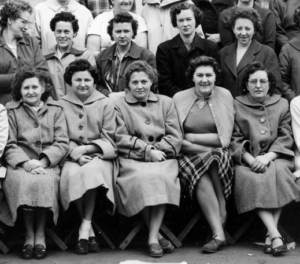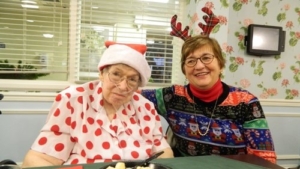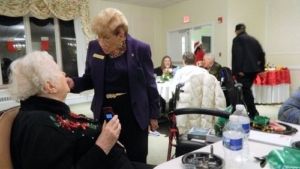Resident Spotlight: Porcelain maker and seamstress Kathryn Steigler found life in America
Porcelain maker and seamstress found life in America!

Kathryn Steigler reminisces about working in a Bavarian porcelain factory after World War II.
The German province of Bavaria is home to one of the world’s rare deposits of kaolin, the clay mineral capable of withstanding the intense firing needed to produce delicate, translucent china. In the unsettled days after World War II, Homeland Center resident Kathryn Steigler worked in a Bavarian porcelain factory, and like Bavaria’s durable clay, emerged from hardship to find her life in America.
Kathryn Schlafman Steigler was born in Hungary in 1925, in a village of ethnic Germans. Her family worked a small subsistence farm, raising their own food and livestock. Her brother tended the horses. She learned from her mother and grandmother to bake bread every day and to weave fabric on a loom and sew it into clothing. Any extra crops were sold to a neighbor’s shop.
“Mom and dad, they worked so hard, and the young ones had to help, too,” she recalls.

Kathryn Steigler (center, front) started working at a Steelton garment factory and, with her seamstress skills, became “forelady.”
Porcelain maker and seamstress found life in America!
World War II upended the family’s way of life. Kathryn’s father died during the war. Her brother vanished. The Communists who regained control of post-war Hungary collectivized the nation’s small farms and expelled ethnic Germans, even though they hadn’t supported the Nazis or the German war effort. Their land confiscated, Kathryn and her mother trekked through East Germany and crossed into West Germany. Settling in northern Bavaria, they lived in old barracks among thousands of other displaced persons hoping to reach America.
In the same region where the Goebel factory was producing its famous Hummel figurines — including those in the collection adorning Homeland’s gathering room – Kathryn found work in a porcelain factory. She worked with the clay mixture that would become plates and cups for diners. Workers would make the mix, put it in a mold, and let it sit until it dried. After the mold was cracked to release the piece for firing, the mold had to be rubbed clean for its next use.
“That’s the way I made my life,” she says. “It wasn’t easy. You had to work for something.”
In Bavaria, Kathryn met her future husband, Alois Steigler, a fellow Hungarian refugee of German heritage.
When they immigrated to America, the sponsor they expected to meet in New York never showed up. Instead of going to Ohio, as originally planned, they went to Steelton, PA, home of Steigler’s uncle.

Kathryn Steigler (underlined, front) and the women she oversaw at Deborah Dress Co., Steelton, posed for a group photo on a winter day in 1960.
In Steelton, the Steiglers joined an immigrant community. Kathryn, raised in a German-speaking village and taught Hungarian in school, learned to speak English. Alois worked in the Bethlehem Steel plant for 30 years before retiring. She worked for 30 years in a factory producing high-end designer clothing for sale in New York. Using her seamstress skills, she became the factory “forelady,” making patterns and teaching the other workers – all women – to turn them into garments.
“I had to teach different girls how to sew a sleeve together, and how to put it on the machine,” she says.
The Steiglers had two sons, one still in the Harrisburg area and another now in Boston. Her two grandsons live in New York City and Boston. She is a member of Trinity Lutheran Church, Steelton.
In all her years, Steigler says she would “keep working wherever I can find it.”
“I know how to work a little bit,” she says. “That’s how I got along, one after another. That’s life. One after another.”







